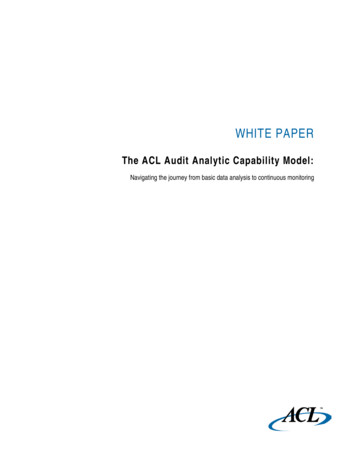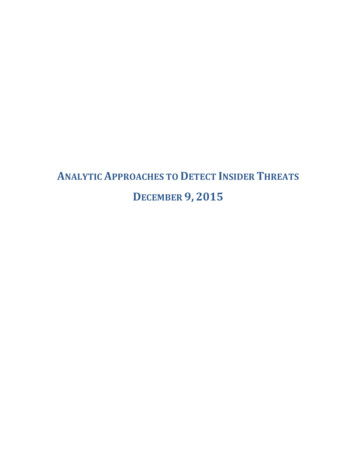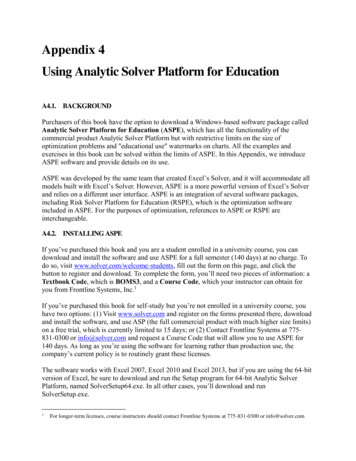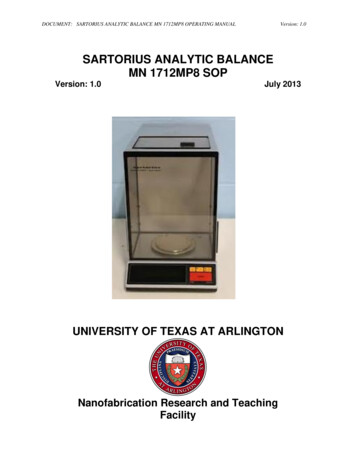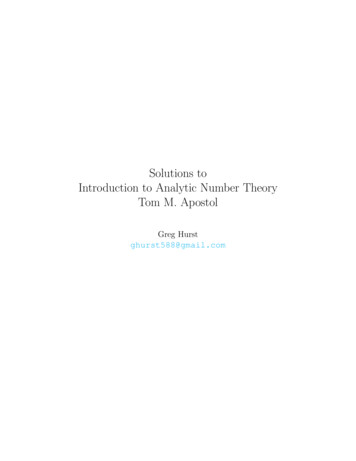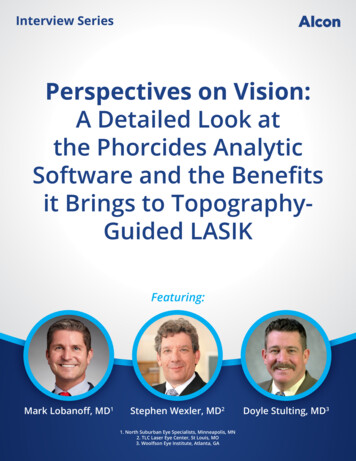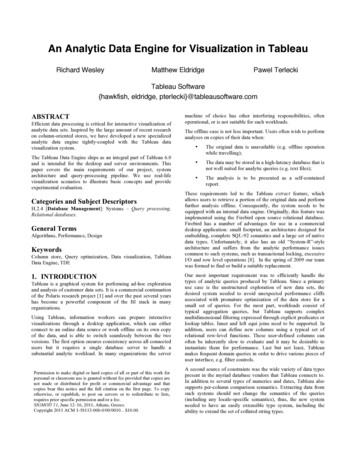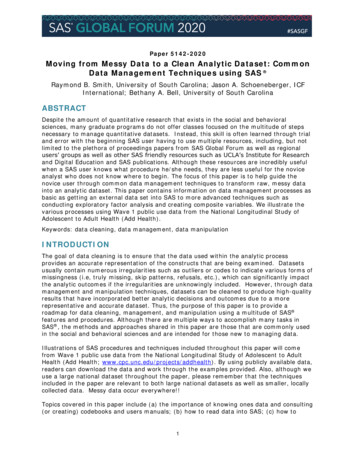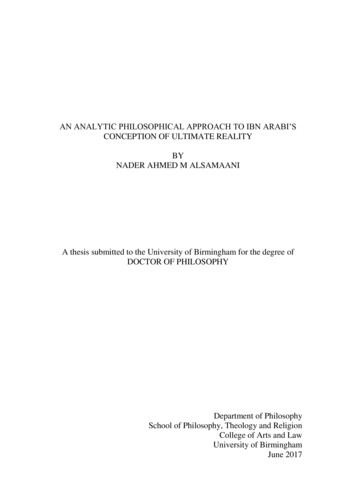
Transcription
AN ANALYTIC PHILOSOPHICAL APPROACH TO IBN ARABI’SCONCEPTION OF ULTIMATE REALITYBYNADER AHMED M ALSAMAANIA thesis submitted to the University of Birmingham for the degree ofDOCTOR OF PHILOSOPHYDepartment of PhilosophySchool of Philosophy, Theology and ReligionCollege of Arts and LawUniversity of BirminghamJune 2017
University of Birmingham Research Archivee-theses repositoryThis unpublished thesis/dissertation is copyright of the author and/or thirdparties. The intellectual property rights of the author or third parties in respectof this work are as defined by The Copyright Designs and Patents Act 1988 oras modified by any successor legislation.Any use made of information contained in this thesis/dissertation must be inaccordance with that legislation and must be properly acknowledged. Furtherdistribution or reproduction in any format is prohibited without the permissionof the copyright holder.
IIAbstractIn my thesis, I aim to develop a systematic and philosophically coherent thesis ofultimate reality for Ibn Arabi. In this pursuit, I adopt the style of analytic philosophy,seeking to employ and utilise some of its methods and theories. The philosophicalaspects of Ibn Arabi’s doctrine are in dire need of conceptual clarification andsystematic analysis with a closer focus on argumentation. The analytic tradition willprove most helpful in this regard.In my thesis, I begin by tracing Ibn Arabi’s related views and concepts as theyare dispersed throughout his writings. I then clarify, sharpen and, in many cases,develop these views and concepts into fully constructed forms. Finally, I weave thedeveloped concepts and views into a systematic thesis or set of sub-theses. Wherenecessary, I provide my own (or borrowed) arguments and concepts to helpsubstantiate and strengthen the structure of Ibn Arabi’s thesis.I propose that Ibn Arabi’s various, and sometimes apparently inconsistent,views are best presented in terms of three main concepts: the concept of ultimatereality as existence (wujud), which has long been known as Ibn Arabi’s thesis of theoneness of existence (wahdat al-wujud); the concept of ultimate reality as the DivineSelf (dhat); and the concept of ultimate reality as God (ilah). The three conceptsneither represent different ultimate realities nor different perspectives of the sameultimate reality. Instead, they represent the same ultimate reality but each one has itsown unique scope and encompassment. The three concepts are aimed atencompassing Ibn Arabi’s various views and concepts of ultimate reality in aconsistent and systematic manner.
IIITo my parents, Ahmed and Munirah
IVAcknowledgementFirstly, I would like to thank God for all the blessings He has brought into my life.Then, I would like to express my sincere gratitude to my supervisor, mentor and, if Imay, friend, Professor Yujin Nagasawa. I am indebted to his continual support of myPhD research, for his patience, motivation and immense knowledge. Since thebeginning, I have been fascinated and impressed by his supervision style, availabilityand enthusiasm; a sentiment that, I realised later, is shared by all his supervisees. Hisguidance and constructive advice have helped me immensely throughout the researchand writing of this thesis. I could not have imagined having a better supervisor andmentor for my PhD study. Also, I would like to thank the University of Birminghamfor offering me whatever assistance I have needed. I would, furthermore, like to thankmy employer, Qassim University, for giving me a scholarship and granting me a studyleave during my work on this PhD thesis. My thanks also go to David Chichester andSimon Mussell for proofreading my thesis. Last but not least, my sincerestgratefulness goes to my parents Ahmed and Munirah; my brothers, particularlyThamer, Mohammed and Muath; my uncle Ibrahim and his family; and my wifeTahani. I could not have completed this work without their everlasting support, careand love. They are the treasure, the blessing and the light of my life.
VTable of ContentsAcknowledgement . IV1. Chapter 1: Introduction . 11.1 Ibn Arabi: A Brief Biography . 11.2 Ibn Arabi and Sufism . 51.3 Ibn Arabi and Traditional Sciences. 91.4 Ibn Arabi and Philosophy . 111.5 Approaches to Ibn Arabi Doctrine . 151.6 The Aim of the Thesis and a Chapter Outline . 182. Chapter 2: The Problem of Ibn Arabi’s Presentation of His Conception of theConception of Ultimate Reality: Speaking on Different Levels . 262.1 Introduction . 262.2 Four Levels of Discourse . 272.2.1. The First Level: The Level of Common Muslims . 292.2.2. The Second Level: The Level of Theologians . 302.2.3. The Third Level: The Level of the Elite People of Allah . 312.2.4. The Fourth Level: The Level of the Highest Elite . 322.3 A Problematic Style . 332.4 Ibn Arabi’s Justification for Speaking on Different Levels . 352.5 Ibn Arabi’s own Doctrine: A Practical Guide. 38Conclusion . 423. Chapter 3: A Critical Evaluation of Izutsu and Chittick’s Overall Approaches to IbnArabi’s Doctrine . 443.1 Introduction . 443.2 Against Izutsu’s interpretation of Ibn Arabi’s Doctrine . 463.2.1. Izutsu’s Interpretive Approach . 463.2.2. Problems with Izutsu’s interpretation . 473.3 Against Chittick’s interpretation of Ibn Arabi’s Doctrine . 533.3.1. Chittick’s Interpretive Approach . 533.3.2. Chittick’s Interpretive Approach is Unwarranted . 58Conclusion . 614. Chapter 4: Ibn Arabi’s Apparently Inconsistent Views and Concepts on UltimateReality . 634.1 Introduction . 634.2 Ibn Arabi’s Apparently Inconsistent Views on the Concept of God . 644.3 Ibn Arabi’s Apparently Inconsistent Views on the Reality of the World . 674.4 Ibn Arabi’s Apparently Inconsistent Views on the Relationship between Godand the World. 68Conclusion . 735. Chapter 5: Ibn Arabi’s Concept of Ultimate Reality as Existence (wujud) (theThesis of wahdat al-wujud) I: Two Interpretations . 755.1 Introduction . 75
VI5.2 Two Interpretations of Ibn Arabi’s Thesis of the Oneness of Existence (wahdatal-wujud) . 775.2.1. Ibn Taymiyyah’s Pantheistic Interpretation . 775.2.2. Affifi and Chittick’s Acosmistic Interpretation . 81Conclusion . 846. Chapter 6: Ibn Arabi’s Concept of Ultimate Reality as Existence (wujud) (TheThesis of wahdat al-wujud) II: My Interpretation . 856.1 Introduction . 856.2 The Metaphysical Nature of Ultimate Reality as Existence (wujud). 886.2.1. The Impossibility of Nothingness and the Necessity of Existence . 886.2.2. Existence is not a Property. 936.2.3. Ibn Arabi’s Views on Existence and the Metaphysical Nature ofUltimate Reality as Existence (wujud) . 996.3 The Metaphysical Nature of the World . 1006.3.1. Al-Mumkinat, Al-A’yan Al-thabitah and the World (al-a’lam) . 1006.3.2. A Theory of Relative Actuality and Mere Possibility . 1056.3.3. The Metaphysical Nature of Possible Entities . 1136.4 The Relationship between Ultimate Reality as Existence (wujud) and the World. 1156.4.1. Possible Entities and God’s Knowledge of the World. 1156.4.2. Identifying God’s Knowledge with the Totality of Possible Entities andthe Problem of God’s Foreknowledge . 1206.5 Maintaining Ibn Arabi’s Statements . 125Conclusion . 1317. Chapter 7: Ibn Arabi’s Concept of Ultimate Reality as Existence (wujud) (TheThesis of wahdat al-wujud) III: Potential Objections . 1347.1 Introduction . 1347.2 The First Objection: The Objection from the Relationship between God and theWorld . 1367.3 The Second Objection: The Objection from the One and the Many . 1407.4 The Third Objection: The Objection from Evil . 1447.5 The Fourth Objection: The Objection from Unfaithfulness to Islam . 146Conclusion . 1498. Chapter 8: Ibn Arabi’s Concept of Ultimate Reality as the Divine Self (dhat) . 1528.1 Introduction . 1528.2 The Scope and the Meaning of the Concept of Ultimate Reality as the DivineSelf (dhat) . 1538.3 Knowing Ultimate Reality as the Divine Self (dhat) . 160Conclusion . 1639. Chapter 9: The Concept of Ultimate Reality as God (ilah) . 1659.1 Introduction . 1659.2 The Scope and the Meaning of the Concept of Ultimate Reality as God (ilah). 167
VII9.3 Knowing Ultimate Reality as God (ilah) . 1699.4 The Concept of Ultimate Reality as God (ilah) and religion . 1809.4.1. Religious Concept(s) of God . 1809.4.2. Ibn Arabi’s Inclusivism . 1859.5 Ultimate Reality and Religion: Another Thesis . 191Conclusion . 196Conclusion . 199Bibliography . 210
1Chapter 1: Introduction1.1Ibn Arabi: A Brief BiographyThe Islamic mystic Muhyddin Abu Bakr Mohammed bin Ali Ibn Arabi al-Ta’i alHatami (known as Ibn Arabi or Ibn al-Arabi) is among the key influential figures inIslamic history. He was born in 1165 AD (569 AH) in Murcia in al-Andalus, amedieval Islamic territory incorporating at its peak most of modern-day Spain andPortugal.Ibn Ara
Ibn Arabi descends from a great Arabic tribe, the Tay’a, in which he seems to take great pride, particularly in being a great grandson of the tribe’s most renowned figure Hatam al-Ta’i, who died a few years before the advent of Islam in the seventh century AD. Hatam is well-known in Arabic culture and literature for his legendary hospitality and generosity, two of the most cherished and .


